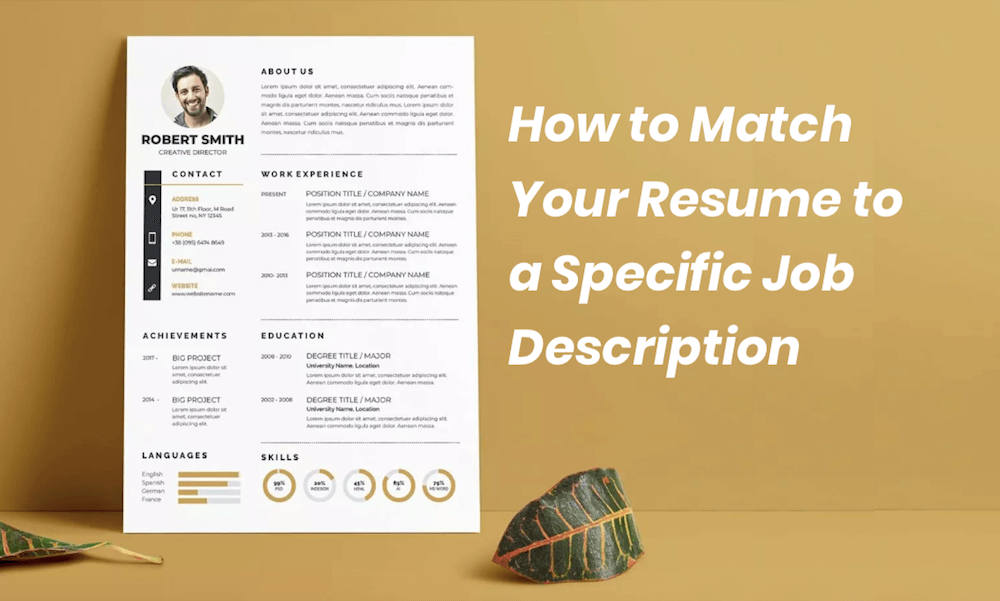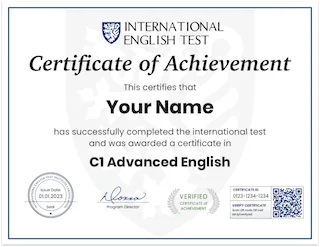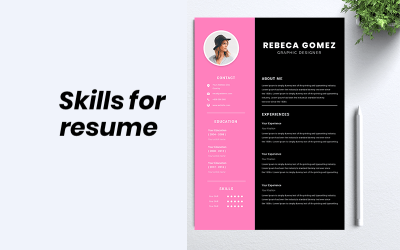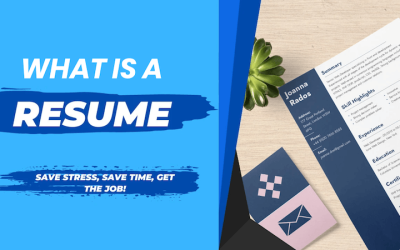You’re on the brink of uncovering a complete guide on customizing your resume for your desired job. However, let’s start with a challenging question:
What attributes does a hiring manager seek in a candidate?
The answer lies in the specific role.
A sales recruiter seeks a proficient salesperson. An engineering recruiter seeks a skilled engineer.
So, how can you leverage your abilities and achievements to persuade the hiring manager that you’re the perfect fit?
The key is tailoring your resume to match each job description and mastering the art of incorporating relevant resume keywords.
You might be thinking: but that sounds time-consuming!
In reality, it’s much simpler than you think.
This article will walk you through the process of tailoring your resume to a particular job or employer by identifying, prioritizing, and strategically placing the desired skills and keywords. Moreover, it will demonstrate how to seamlessly connect these skills to your accomplishments.
What is your English level?
Find out your A1 A2 B1 B2 C1 C2 level of English with our online test and receive your English certificate.
Why You Need to Tailor a Resume
On an average scale, numerous recruiters contend with an influx of up to 250 applicants when a job opportunity is posted.
Being part of this pool inevitably shrinks your resume down to a mere speck in a vast expanse.
Moreover, recruiters have devised tactics to weed out unsuitable candidates, streamlining their process but complicating yours.
They employ a dual strategy: the utilization of Applicant Tracking Systems (ATS) and swift scanning.
Both methods incorporate a keyword scan, differing only in whether it’s conducted by a human or a digital system like R2D2. Interestingly, R2D2 is employed by around 70% of larger organizations for this purpose.
The most effective countermeasure is to inundate your ATS-friendly resume with keywords from the job description itself – essentially, tailoring your resume to the specific role.
“Keywords hold immense significance as they serve as the principal method through which recruiters discover potential candidates on platforms like LinkedIn and within their HR systems, such as ATS. A candidate whose resume lacks precise matching keywords might remain unnoticed in these searches. The most effective means of identifying pivotal keywords is by referring to the job description itself.” – James Hu (Founder/CEO at Jobscan)
Seems intricate, right? In reality, it’s incredibly straightforward.
To kick things off, take a look at this illustrative example of a job description and a tailored resume:
Pay attention to the prominent resume keywords in the job description.
Notice how they are integrated into the resume?
Your goal should be to incorporate these keywords across your entire resume, encompassing the resume profile (resume summary or resume objective), skills, and work experience.
Let’s delve into the step-by-step process together. Keep reading…
No One Keeps A Master List, But it Works So Well
To start, compile a comprehensive inventory of your skills.
Catalog all your abilities, even unconventional ones like the knack for tying a cherry stem with your tongue. Why, you ask?
Enlisting diverse skills sparks your imaginative potential.
Next, arrange your vocational proficiencies in order of significance, commencing with your most potent and esteemed skills. Encompass soft skills, hard skills, and the entire spectrum.
This roster will come in handy while appraising the relevance of your skills vis-à-vis those delineated in the job description.
Now, I’ll guide you through the process of customizing your resume and competencies to a specific job description.
How to Find the Keywords You Need to Tailor a Resume
Sure thing, you’re set to delve into your job description for skills.
Highlight any and all abilities and experiences that resonate with you. Here’s the method: And voilà! You’ve got your keywords.
As long as you possess these skills, incorporate all of them into your resume.
But what’s their fate?
Well, that hinges on their significance. How can you determine that?
Start by identifying a handful of roles akin to yours. Then, accentuate the skills. Compose a catalog of skills that intersect. Lastly, scout LinkedIn for professionals carrying the same job title as your job listing.
It’s worth noting that individuals who have adeptly optimized their LinkedIn profiles would have integrated keywords.
This is because incorporating keywords on LinkedIn heightens your profile’s discoverability. Here’s how you put keywords to work for optimizing your LinkedIn profile.
Search for these keywords within their skills and experience sections.
If they align with any skills on your list of overlapping proficiencies, chances are they’re the most valuable and in-demand. Pro Tip: Once you’ve fine-tuned your resume to the job description, circle back to your lists and introduce pertinent skills to your resume that weren’t explicitly listed in the job offer.
Are you C1 Advanced English?
Get your C1 Advanced English certificate now!
✓ Add your certificate to your resume
⭐ ⭐ ⭐ ⭐ ⭐
Here’s How to Categorize Your Skills Before Tailoring Your Resume
By categorizing your most crucial skills, you can strategically arrange them on your resume, enhancing your ability to customize it to a specific job description or employer.
These abilities can be classified into three types:
- Job-specific
- Transferable
- Adaptive
Job-Related Qualifications
These hold the utmost importance as they are prerequisites.
Let’s consider you’re in pursuit of a role as a Software Developer.
According to the job description, proficiency in Java is an essential requirement. Without Java knowledge, you can’t effectively perform the tasks.
Essential skills should be positioned in the upper segment of your resume, ensuring that recruiters quickly recognize your qualifications.
These can be incorporated into your resume summary or objective.
For instance:
Software Developer with over 5 years of experience, demonstrating attention to detail. Proficient in Java and C++.
It’s worth noting that “attention to detail” is a typical instance of an adaptive skill, which we’ll delve into shortly.
But why is the top portion so pivotal?
This is the initial area where a hiring manager directs their attention. Keep in mind, they are initially scanning. Therefore, your prime skills should be easily noticeable within seconds.
Transferable Abilities
Transferable skills encompass those that can be applied across various job roles. They encompass proficiencies like Microsoft Office usage or multilingual capabilities such as Spanish fluency.
Review your task inventories, ensuring you possess two distinct lists:
- A comprehensive catalog of your most potent skills.
- A compilation of skills that exhibit overlaps.
Within the job description, identify transferable skills.
Do any of these align with your overlapping skills? Are any of them positioned prominently in your personal skills list?
Should this be the case, integrate the most pivotal skills into your work experience section on the resume. The remaining skills can find a place in the skills segment.
Adaptability Skills
These are the proficiencies that facilitate your “adjustment” within society, encompassing intangible attributes like ethics and discretion.
Incorporating them effectively involves using them to characterize yourself, similar to the prior example:
Software Developer with 5+ years of experience who is detail-oriented. Expertise in Java and C++.
Detail-orientedness exemplifies a valuable adaptive skill. Identify adaptable skills frequently listed and select those that best encapsulate your resume’s essence.
Have you contemplated adding a Hobbies & Interests section?
Both hobbies and adaptive skills offer exceptional avenues to showcase your personality.
For instance, to spotlight your attention to detail, engage in a hobby that necessitates it.
Discover the rationale behind and strategies for incorporating hobbies and interests in your resume to project your personality.
Students can also augment their resumes by integrating hobbies.
Draw Attention to Your Keywords Using Numbers and Achievements
Once you’ve incorporated all your keywords, it’s time to illuminate them.
Setting your CV apart involves showcasing how effectively you put your skills into action.
Enhancing your keywords with specifics like statistics and achievements can invigorate your resume.
For instance:
Let’s say you’re aspiring to be a server at an upscale restaurant. The job description emphasizes the importance of exceptional customer service.
You initially include “responsible for customer service” as a bullet point under your current retail role.
But hold on, what does “responsible for customer service” really convey?
Not much.
Instead, craft it like this:
“Through the delivery of exceptional customer service, we achieved a 10% reduction in returns.”
Why?
Firstly, the numerical value will immediately draw the hiring manager’s attention to this point—where you’ve embedded the crucial term verbatim.
(You’ve aced the scanning process.)
Secondly, the hiring manager will see how your customer service skills translate into tangible outcomes. Effective customer service under your management leads to higher customer satisfaction, resulting in fewer product returns.
(You’ve just secured an interview.)
Here’s How to Check If You Tailored Your Resume Well
After customizing your resume, it’s time to evaluate your efforts.
Utilize a word cloud generator to analyze your resume. It will visualize the frequency of word usage.
If your keywords aren’t prominently featured, consider incorporating them more.
Did you apply that skill in multiple roles?
Remember, automated systems can detect whether skills have been added randomly or purposefully.
Next, utilize Jobscan’s ATS simulator. Input your job description and resume into their tool to assess keyword usage.
If your match is below 80%, Jobscan will offer personalized suggestions to enhance your application.
Pro Tip: Customize your cover letter with keywords from the job description.
Additionally, a robust cover letter that complements your resume will give you a competitive edge.
Here’s a potential example:
Tailoring your resume to the job description is crucial, and this advice is universally applicable.
By aligning your resume with the job description, you signal to the hiring manager that your experience is pertinent and that you are the ideal candidate for the role.
So, if you’ve ever wondered why interview calls are elusive, it might be time to ditch the generic resume and instead prioritize customization for each job opportunity, coupled with a thorough resume review.
What is your English level?
Find out your A1 A2 B1 B2 C1 C2 level of English with our online test and receive your English certificate.
I am Nilay, an experienced English Language Assessment Director at the International English Test, where I have been working full-time since February 2020. I specialize in helping people worldwide validate their English proficiency through comprehensive assessments and certifications.
Before joining the International English Test, I worked as a self-employed English Language Assessment Consultant from January 2015 to December 2019. During this time, I assisted companies and individuals in improving their language skills, helping them achieve their academic and professional goals.
I hold a degree in Engineering and have also studied at Shafston International College in Australia. My educational background has equipped me with the tools to make a meaningful impact in the field of English language learning. Additionally, I enjoy sharing my expertise through articles that explore effective teaching methods and language assessment strategies, contributing to the International English Test and the broader assessment community.





